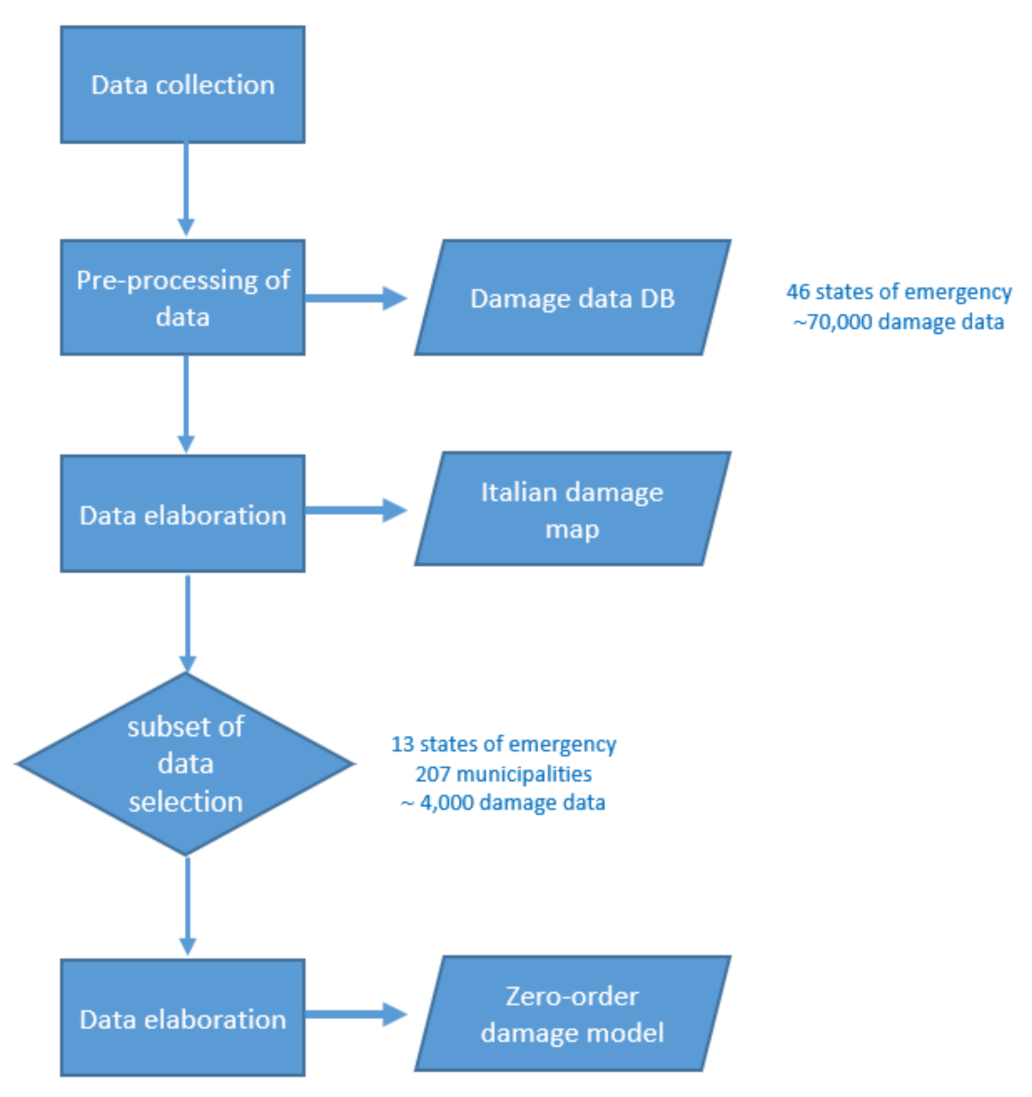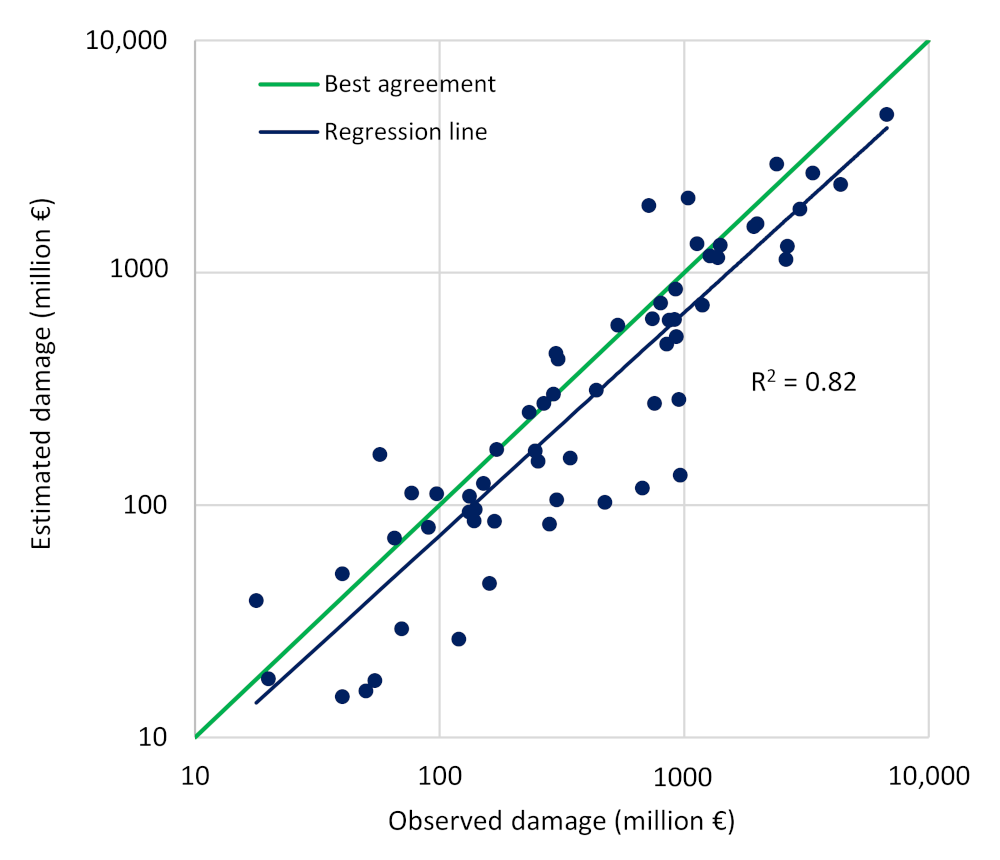A Zero-Order Flood Damage Model for Regional-Scale Quick Assessments
Abstract
:1. Introduction
- The definition of the national picture of flood damage in the past decade with a spatial resolution at the municipality level;
- The derivation of an empirical damage model for a quick preliminary estimation of the expected damage in case of flood, grounded on the simple knowledge of the affected area.
2. Materials and Methods
2.1. Background
2.2. Data Collection and Availability
2.3. Data Elaboration: Objectives and Models
3. Results
3.1. Map of Observed Damage
3.2. Zero-Order Flood Damage Model
4. Discussion
- Damage figures and models do not consider damage due to high-frequency events i.e., floods from smaller streams, due to sewerage system crisis and, more generally, all minor events which do not require the intervention of a Deputy Commissioner but do have, however, a strong influence on damage generation; the model is indeed focused on floods, while as far as hydrogeological instability is concerned, other types of hypotheses and models should be further provided;
- The dataset covers nearly 80% of the overall claims;
- Compensation requests for public assets are often taken as an opportunity to carry out works that are often postponed by public bodies for lack of funding, such as the seismic adaptation of structures, energy optimization, improvement of electrical and plumbing systems, and so on. This may lead to an overestimation of damage to public items.
5. Further Developments
6. Conclusions
Author Contributions
Funding
Institutional Review Board Statement
Informed Consent Statement
Data Availability Statement
Acknowledgments
Conflicts of Interest
References
- Meyer, V.; Becker, N.; Markantonis, V.; Schwarze, R.; Van Den Bergh, J.; Bouwer, L.; Bubeck, P.; Ciavola, P.; Genovese, E.; Green, C.H. Assessing the costs of natural hazards-state of the art and knowledge gaps. Nat. Hazards Earth Syst. Sci. 2013, 13, 1351–1373. [Google Scholar] [CrossRef]
- Merz, B.; Kreibich, H.; Schwarze, R.; Thieken, A. Assessment of economic flood damage. Nat. Hazards Earth Syst. Sci. 2010, 10, 1697–1724. [Google Scholar] [CrossRef]
- Dottori, F.; Figueiredo, R.; Martina, M.L.; Molinari, D.; Scorzini, A.R. INSYDE: A synthetic, probabilistic flood damage model based on explicit cost analysis. Nat. Hazards Earth Syst. Sci. 2016, 16, 2577–2591. [Google Scholar] [CrossRef] [Green Version]
- Menoni, S.; Molinari, D.; Ballio, F.; Minucci, G.; Mejri, O.; Atun, F.; Berni, N.; Pandolfo, C. Flood damage: A model for consistent, complete and multipurpose scenarios. Nat. Hazards Earth Syst. Sci. 2016, 16, 2783–2797. [Google Scholar] [CrossRef] [Green Version]
- Schröter, K.; Kreibich, H.; Vogel, K.; Riggelsen, C.; Scherbaum, F.; Merz, B. How useful are complex flood damage models? Water Resour. Res. 2014, 50, 3378–3395. [Google Scholar] [CrossRef] [Green Version]
- De Grove, T.; Poljansek, K.; Ehrlich, D. Recording Disaster Losses. In Recommendations for a European Research; JRC Scientific and Policy Reports; Joint Research Centre, European Commission: Luxembourg, 2013. [Google Scholar]
- De Grove, T.; Poljansek, K.; Ehrlich, D.; Corbane, C. Current Status and Best Practices for Disaster Loss Data Recording in EU Member States: A Comprehensive Overview of Current Practice in the EU Member States; JRC Scientific and Policy Reports; JRC92290; Publications Office of the European Union: Luxembourg, 2014. [Google Scholar] [CrossRef]
- EU Commission—EU Expert Working Group on Disaster Damage and Loss Data. Guidance for Recording and Sharing Disaster Damage and Loss Data: Towards the Development of Operational Indicators to Translate the Sendai Framework into Action; JRC Scientific and Policy Reports, JRC95505; Publications Office of the European Union: Luxembourg, 2015. [Google Scholar] [CrossRef]
- Spekkers, M.H.; Ten Veldhuis, J.A.E.; Kok, M.; Clemens, F.H.L.R. Analysis of pluvial flood damage based on data from insurance companies in the Netherlands. In Proceedings of the International Symposium Urban Flood Risk Management, UFRIM, Graz, Austria, 21–23 September 2011. [Google Scholar]
- André, C.; Monfort, D.; Bouzit, M.; Vinchon, C. Contribution of insurance data to cost assessment of coastal flood damage to residential buildings: Insights gained from Johanna (2008) and Xynthia (2010) storm events. Nat. Hazards Earth Syst. Sci. 2013, 13, 2003–2012. [Google Scholar] [CrossRef] [Green Version]
- Kellermann, P.; Schröter, K.; Thieken, A.H.; Haubrock, S.-N.; Kreibich, H. The object-specific flood damage database HOWAS 21. Nat. Hazards Earth Syst. Sci. 2020, 20, 2503–2519. [Google Scholar] [CrossRef]
- Mobley, W.; Sebastian, A.; Highfield, W.; Brody, S.D. Estimating flood extent during Hurricane Harvey using maximum entropy to build a hazard distribution model. J. Flood Risk Manag. 2019, 12, 12549. [Google Scholar] [CrossRef] [Green Version]
- Guzzetti, F.; Tonelli, G. Information system on hydrological and geomorphological catastrophes in Italy (SICI): A tool for managing landslide and flood hazards. Nat. Hazards Earth Syst. Sci. 2004, 4, 213–232. [Google Scholar] [CrossRef]
- Handmer, J. The chimera of precision: Inherent uncertainties in disaster loss assessment. Aust. J. Emerg. Manag. 2003, 18, 88–97. [Google Scholar]
- Gizzi, F.T.; Potenza, M.R.; Zotta, C. The insurance market of natural hazards for residential properties in Italy. Open J. Earthq. Res. 2016, 5, 35. [Google Scholar] [CrossRef] [Green Version]
- Bignami, D.F.; Rulli, M.C.; Rosso, R. Testing the use of reimbursement data to obtain damage curves in urbanised areas: The case of the Piedmont flood on October 2000. J. Flood Risk Manag. 2018, 11, S575–S593. [Google Scholar] [CrossRef] [Green Version]
- Dipartimento della Protezione Civile. Emergenze per il Rischio Meteo-Idro. Available online: http://www.protezionecivile.gov.it/amministrazione-trasparente/interventi-straordinari-emergenza/emergenze-rischio-meteo-idro (accessed on 17 March 2021).
- Bignami, D.F.; Dragoni, A.; Menduni, G. Assessing and improving flood and landslide community social awareness and engagement via a web platform: The case of Italy. Int. J. Disaster Risk Sci. 2018, 9, 530–540. [Google Scholar] [CrossRef] [Green Version]
- Luino, F.; Chiarle, M.; Nigrelli, G.; Agangi, A.; Biddoccu, M.; Cirio, C.G.; Giulietto, W. A model for estimating flood damage in Italy: Preliminary results. Wit Trans. Ecol. Environ. 2006, 98. [Google Scholar] [CrossRef] [Green Version]
- Carisi, F.; Schröter, K.; Domeneghetti, A.; Kreibich, A.; Castellarin, A. Development and assessment of uni-and multivariable flood loss models for Emilia-Romagna (Italy). Nat. Hazards Earth Syst. Sci. 2018, 18, 2057–2079. [Google Scholar] [CrossRef] [Green Version]
- Huizinga, J.; De Moel, H.; Szewczyk, W. Global Flood Depth-Damage Functions: Methodology and the Database with Guidelines; JRC Working Paper; JRC105688; Joint Research Centre: Seville, Spain, 2017. [Google Scholar]
- Thieken, A.H.; Olschewski, A.; Kreibich, H.; Kobsch, S.; Merz, B. Development and evaluation of FLEMOps—A new Flood Loss Estimation MOdel for the private sector. Wit Trans. Ecol. Environ. 2008, 118, 315–324. [Google Scholar]
- Penning-Rowsell, E.; Priest, S.; Parker, D.; Morris, J.; Tunstall, S.; Viavattene, C.; Chatterton, J.; Owen, D. Flood and Coastal Erosion Risk Management: A Manual for Economic Appraisal; Routledge: London, UK, 2014. [Google Scholar]
- Büchele, B.; Kreibich, H.; Kron, A.; Thieken, A.; Ihringer, J.; Oberle, P.; Merz, B.; Nestmann, F. Flood-risk mapping: Contributions towards an enhanced assessment of extreme events and associated risks. Nat. Hazards Earth Syst. Sci. 2006, 6, 485–503. [Google Scholar] [CrossRef]
- Smith, D.I. Flood damage estimation-A review of urban stage-damage curves and loss functions. Water Sa 1994, 20, 231–238. [Google Scholar]
- ISTAT, Istituto Nazionale di Statistica. Available online: https://www.istat.it/it/archivio/6789 (accessed on 17 March 2021).
- Voigt, S.; Giulio-Tonolo, F.; Lyons, J.; Kučera, J.; Jones, B.; Schneiderhan, T.; Platzeck, G.; Kaku, K.; Hazarika, M.K.; Czaran, L. Global trends in satellite-based emergency mapping. Science 2016, 353, 247–252. [Google Scholar] [CrossRef]
- Ajmar, A.; Boccardo, P.; Broglia, M.; Kucera, J.; Giulio-Tonolo, F.; Wania, A. Response to flood events: The role of satellite-based emergency mapping and the experience of the Copernicus emergency management service. Flood Damage Surv. Assess. New Insights Res. Pract. 2017, 228, 213–228. [Google Scholar]
- Duo, E.; Trembanis, A.C.; Dohner, S.; Grottoli, E.; Ciavola, P. Local-scale post-event assessments with GPS and UAV-based quick-response surveys: A pilot case from the Emilia–Romagna (Italy) coast. Nat. Hazards Earth Syst. Sci. 2018, 18, 2969–2989. [Google Scholar] [CrossRef] [Green Version]
- PON Governance e Capacità Istituzionale. Available online: http://www.pongovernance1420.gov.it/it/ (accessed on 17 March 2021).
- Molinari, D.; Scorzini, A.R.; Arrighi, C.; Carisi, F.; Castelli, F.; Domeneghetti, A.; Gallazzi, A.; Galliani, M.; Grelot, F.; Kellermann, P. Are flood damage models converging to “reality”? Lessons learnt from a blind test. Nat. Hazards Earth Syst. Sci. 2020, 20, 2997–3017. [Google Scholar] [CrossRef]
- Cammerer, H.; Thieken, A.H.; Lammel, J. Adaptability and transferability of flood loss functions in residential areas. Nat. Hazards Earth Syst. Sci. 2013, 13, 3063–3081. [Google Scholar] [CrossRef] [Green Version]
- Association of State Floodplain Managers. Flood Mapping for the Nation: A Cost Analysis for Completing and Maintaining the Nation’s NFIP Flood Map Inventory; Association of State Floodplain Managers: Madison, WI, USA, 2020. [Google Scholar]








| Public Assets | Private Assets | Productive Activities | Total | |
|---|---|---|---|---|
| Total reported damages [M€] | 6643.82 M€ | 1047.27 M€ | 1158.16 M€ | 8849.24 M€ |
| Available for research [M€] | 4936.72 M€ | 825.93 M€ | 1090.97 M€ | 6853.63 M€ |
| Available for research [%] | 74.3% | 78.8% | 94.1% | 77.4% |
| Total Available Dataset | Refined Dataset | |
|---|---|---|
| Number of emergency states | 13 | 8 |
| Number of hit municipalities | 207 | 149 |
| Number of claims | 4104 | 3729 |
| Total observed damage [€] | 129 million | 108 million |
| Claim for Damage Type | Number of Claims | Average Amount Per Claim [€] |
|---|---|---|
| Public assets | 22,411 | 220,281 € |
| Private assets | 38,129 | 21,662 € |
| Productive activities | 12,463 | 87,537 € |
| Total | 73,003 | 93,881 € |
Publisher’s Note: MDPI stays neutral with regard to jurisdictional claims in published maps and institutional affiliations. |
© 2021 by the authors. Licensee MDPI, Basel, Switzerland. This article is an open access article distributed under the terms and conditions of the Creative Commons Attribution (CC BY) license (https://creativecommons.org/licenses/by/4.0/).
Share and Cite
Pogliani, A.; Bertulessi, M.; Bignami, D.F.; Boschini, I.; Del Vecchio, M.; Menduni, G.; Molinari, D.; Zambrini, F. A Zero-Order Flood Damage Model for Regional-Scale Quick Assessments. Water 2021, 13, 1292. https://doi.org/10.3390/w13091292
Pogliani A, Bertulessi M, Bignami DF, Boschini I, Del Vecchio M, Menduni G, Molinari D, Zambrini F. A Zero-Order Flood Damage Model for Regional-Scale Quick Assessments. Water. 2021; 13(9):1292. https://doi.org/10.3390/w13091292
Chicago/Turabian StylePogliani, Arianna, Manuel Bertulessi, Daniele F. Bignami, Ilaria Boschini, Michele Del Vecchio, Giovanni Menduni, Daniela Molinari, and Federica Zambrini. 2021. "A Zero-Order Flood Damage Model for Regional-Scale Quick Assessments" Water 13, no. 9: 1292. https://doi.org/10.3390/w13091292
APA StylePogliani, A., Bertulessi, M., Bignami, D. F., Boschini, I., Del Vecchio, M., Menduni, G., Molinari, D., & Zambrini, F. (2021). A Zero-Order Flood Damage Model for Regional-Scale Quick Assessments. Water, 13(9), 1292. https://doi.org/10.3390/w13091292









